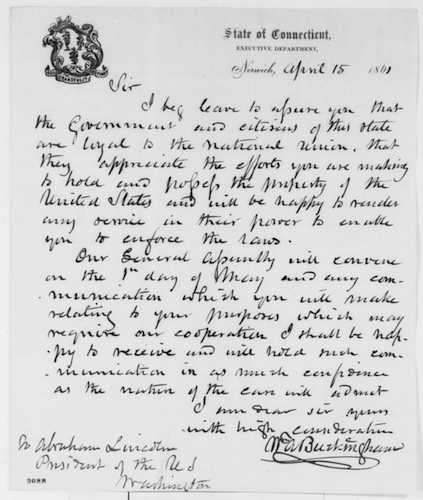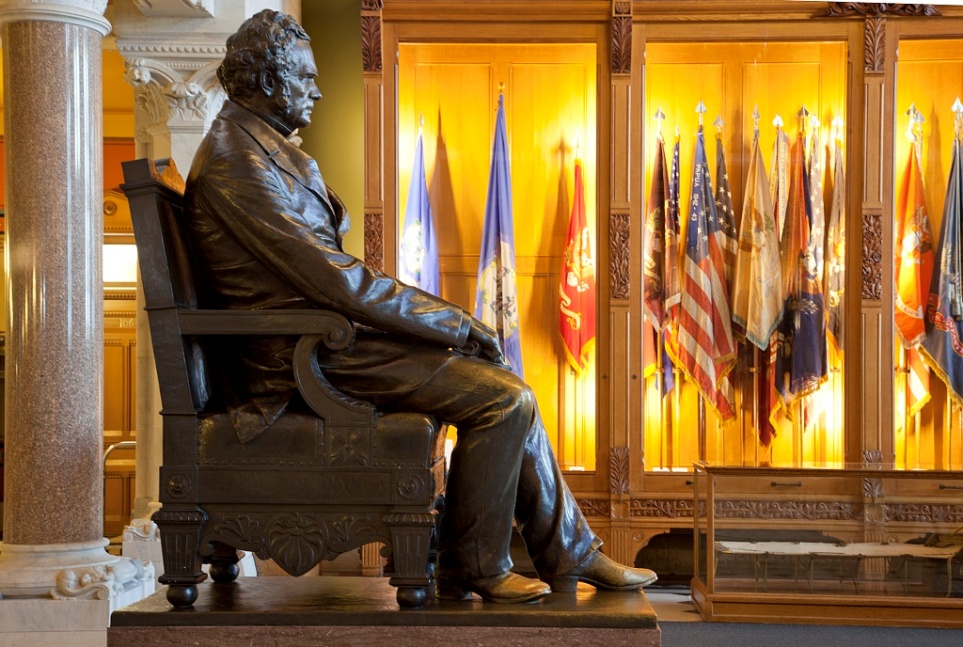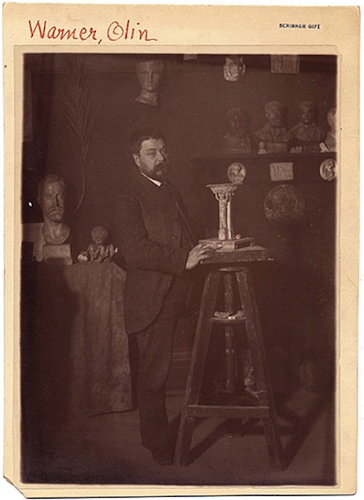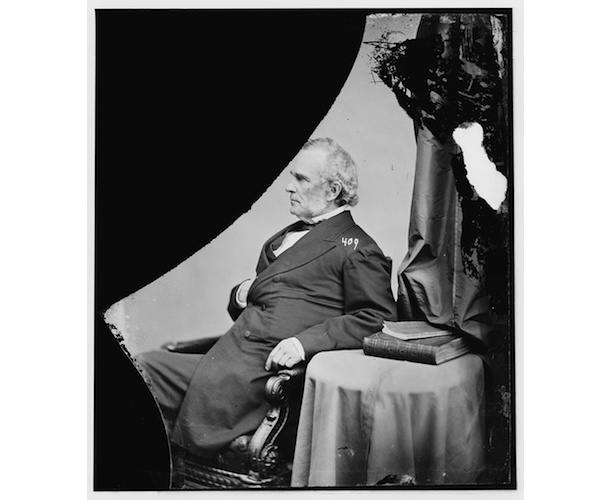By David Lucian
Growing up in Lebanon, Connecticut, William Buckingham spent his entire life as a resident of the Nutmeg State. An ambitious student, Buckingham attended Bacon Academy in Colchester where he pursued mathematics, civil engineering, and land surveying. After schooling, he succeeded as a surveyor, store owner, and religious school teacher. While working at a small department store, Buckingham learned valuable business skills that helped Connecticut prosper economically during the war.
Governor Buckingham and the War Effort

William A. Buckingham letter to Abraham Lincoln regarding support of Connecticut, Monday, April 15, 1861 – Library of Congress, American Memory, Abraham Lincoln Papers
Often working around the clock, the governor felt personally obliged to give his all to the state, even investing his own capital to help fund the war. On several occasions he took out personal loans to pay soldiers for their service. During the war, the governor kept in close contact with Union leaders, including President Lincoln, who recognized the remarkable effort that he put forth. However, the governor had to fight opposition in Connecticut. Criticism for the war and the Union littered the papers, but Buckingham kept Connecticut largely unified.
With men across the nation injured and dying and with no end to the war in sight, Governor Buckingham continued to ask Connecticut residents to enlist in the Union army. With a population of only 475,000, the governor had a limited number of able men to fight the war. By the war’s end, 55,000 Connecticut men were sent to battle. In his yearly message to the people of Connecticut, Buckingham continued to ask for more from his constituents. Thousands in Connecticut volunteered to fight, and few needed to be drafted to reach Lincoln’s quota for the state. The governor spent as much time and money as was needed to make sure the troops were properly prepared for battle. He recognized the importance of having quality guns, uniforms, and equipment and the governor’s relentless efforts to equip his men did not go unnoticed. President Lincoln commended the troops he received from Connecticut, stating, “The Connecticut regiments give me no trouble; Governor Buckingham always sends them fully equipped for any emergency.” Buckingham also raised money for his troops and when possible, he visited the camps. In one visit, someone asked the governor if he could make sure the pay master could visit the troops because he was late on paying them. Governor Buckingham went one step further and left a personal check for his troops, covering all their salaries.

Hall of Flags, State Capitol, Hartford
– Library of Congress, Prints and Photographs Division, Carol M. Highsmith Archive – George F. Landegger Collection
Buckingham Statue at the Capitol
Governor Buckingham’s statue is located in the State Capitol’s Hall of Flags. As Samuel Buckingham stated in the biography of his brother, “The statue of Buckingham is appropriately here. Its position in this part of the Capitol, in which are placed the sad but honored trophies of our State in the War of the Rebellion, adds to its memorial significance, and these worn and blood stained battle flags, standing like so many sentinels of honor to guard it, add to its glory.” The devoted governor did everything he could to help the Union and to protect his troops. Buckingham statue committee member, Henry Harrison, said before the unveiling that “it was particularly fitting that the statue should be placed in the battle flag vestibule, where were gathered the flags of the Connecticut regiments, in whose hands Governor Buckingham had placed them, and to whose hands they were returned.”
Buckingham Day: The Celebration for Connecticut’s War Governor

Olin Levi Warner, ca. 1874 – Smithsonian Institution, Archives of American Art
The state honored Governor Buckingham 20 years after the Civil War ended. The state funded the celebration with a $10,000 grant (which would cost around $250,000 in today’s dollars). People from all over the state came to honor the governor on June 18, 1884, also known as “Buckingham Day.” Over 7,500 soldiers, new and old, marched with their battle flag in hand as the ceremony began. The parade lasted about two hours as the soldiers made their way to the Connecticut State Capitol. Seventy thousand onlookers watched the magnificent ceremony from the streets of Hartford. Once the parade ended, the unveiling of the statue was held inside the Connecticut State Capitol. The life-sized Buckingham statue, made out of bronze and placed on top of a marble stand, awed the crowd. Sculptor Olin L. Warner wanted to bring the outstanding governor to life, and put meaning in every part of the statue. From the sitting position of Buckingham, to the paper in-hand, Warner desired Buckingham to look busy at work, but also friendly and approachable. Buckingham’s popularity and his heroics as governor are well-depicted in his memorial.
David Lucian is a master’s student of history at Central Connecticut State University and a graduate assistant for the history department. He also holds a bachelor’s degree in Criminal Justice.
This article was published as part of a semester-long graduate student project at Central Connecticut State University that examined Civil War monuments and their histories in and around the State Capitol in Hartford, Connecticut.
<< Previous – Home – Next >>









